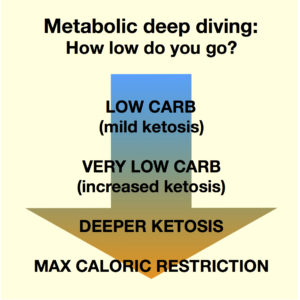
Combine healthy food restriction with a great metabolism and the right physical activities to grow older more slowly — we really can influence aging!
Calorie restriction is the primary lifestyle influence on aging, but using this knowledge is easier said than done unless you adopt a healthy approach. When it’s done correctly, calorie restriction not only slows aging, it also increases ketones and fat-burning, and can improve overall health.
Everything in our life influences everything else. For example, low-intensity exercise supports calorie restriction and also helps improve fat-burning.
To avoid being overwhelmed by all the different factors, prioritizing each can provide more health and fitness benefits with fewer lifestyle changes. Consider the risks of chronic disease and infection, pain, injury and disability, improving athletic performance, and building a better brain — these make up almost all concerns and complaints by most people. By focusing on aging, we could address all these other issues.
Generally, people are healthier, more fit, and overall better at life at younger versus older ages. One possible exception may be a healthy mind, which generally does not peak until around midlife or later, then begins declining like most other functions. By maintaining a creative, inquiring and healthy brain, we could almost continuously improve it.
Ketones
We all produce and utilize ketones for energy every day, regardless of how we eat. A healthier lifestyle can significantly increase ketosis, especially with rising fat-burning. Food is the primary influence, affecting many aspects of physical, biochemical and mental-emotional well-being — all of these influence aging. These benefits are accomplished by consuming foods that are high-energy. This means higher-fat, moderate protein, very-low carbohydrate. (Ketosis can also express our genes for increased fat burning.)
Of course, ketosis is not a diet, or a trendy cool thing to try. It will, unfortunately, appear on restaurant menus and elsewhere soon, not unlike the gluten-free trend; remember the old “heart healthy” trend? Ketosis is much more — maintaining higher levels can reduce caloric needs.
Healthy calorie restriction
For ages, researchers have described calorie restriction as the primary way to slow aging. The question has always been how to accomplish this without reducing nutrition, being hungry, and while maintaining high energy.
There is a healthy, natural way to accomplish this feat. By restricting food intake we can check aging, prevent chronic disease and live a vibrant life.
Unfortunately, common calorie restriction is unhealthy because of unhealthy eating — low-fat, refined carbs — that trash metabolism and promote malnutrition. Despite its failure to sustain weight loss or promote health, this trend has been popular for decades.
Instead, a healthy approach is to eliminate junk food, part of reducing carbohydrate intake, and consume higher amounts of healthy fats, and moderate protein. As we adapt to this healthy eating style, nutritional needs are reduced, leading to less caloric requirements.
In short, this adaptation occurs from an improved metabolism associated with increased fat-burning and ketone production. The result is slowing of the aging process, increased quality and quantity of life, along with many other benefits. The process is made easier as our hunger diminishes significantly while maintaining high energy. Caloric requirements can reduce 20, 30, 40 or more percent.
(It won’t be long before the failed low-cal proponents start taking credit for ketogenic diets, claiming they are the same as the old low-cal diets.)
Reduced nutrient needs
As metabolism improves, more energy is generated from less food and calories. Other nutritional needs may also be reduced
Consider protein. Adequate protein intake is still vital during calorie restriction, although intake requirements may be lower as we become metabolically more efficient. For example, this amount may be on the lower end of the healthy protein intake range, such as 1+ grams of protein per kilogram of body weight, rather than 2+ grams. Healthy ketosis has been recommendation to prevent excess muscle loss and strength (sarcopenia) during aging.
The exercise-food formula
The combination of healthy foods with exercise factors, particularly intensity and duration, significantly influence fat-burning and physical performance.
Exercise intensity is a key part of the formula, with increasing intensity reducing fat-burning. Being aerobically fit burns more fat at all intensities. (While women have higher body fat percentages, they can also burn more fat than men, as demonstrated in their relative improved endurance capacity compared to other sports.)
As metabolism improves and fat-burning and ketones increase, there is a point where more fat is burned than fat consumed.
Thus, the formula includes:
- Training slower to burn more fat — using the MAF HR
- Consuming meals higher in fat, moderate protein, and low or very-low in carbs.
- As ketosis develops overall caloric needs reduce — caloric restriction.
- Hunger can help guide your transition to this healthier state. While fat-burning increases right away, it could take one to two months to rev up fat-burning, then longer to fully adapt to increasing calorie restriction.
- The rate of adaptation also depends on your existing metabolism, dedication (how strict you are), and personalization — matching your level of carbohydrate intolerance.
Personalizing your needs
For decades, many have successfully used the Two-Week Test to determine their levels of carbohydrate intolerance, reducing hunger and adjusting caloric intake. Without junk food, hunger and sugar addiction, satisfying meals are higher in fat, but with less food, and lower in calories.
Those with excess body fat are more carbohydrate intolerant, and can jump ahead to the Two-Week Keto Test to move deeper into ketosis making the transition to a healthier metabolism faster.
Our optimal level of healthy calorie restriction is individual. The need to go deeper depends on the level of physical activity and aerobic status, and also increased:
• Carbohydrate intolerance
• Age
• Risk or appearance of chronic disease
• Presence of abnormal signs and symptoms, including pain, excess body fat, hunger and sugar addiction.
A bonus
A metabolic bonus that further impacts aging is natural (intermittent) fasting — something humans have always done. This makes your food-free periods easier, where hunger is a stranger. But don’t fast by numbers — counting the hours — regardless of the latest trend. No need to go too long without food. The natural desire to eat may mean … you should eat! When caloric restricted, the associated fasting feature works as well whether one eats one meal a day or several smaller ones. What’s most important is maintaining a natural circadian fasting pattern — eat during the day and avoiding food the other half or more of the day.
Other nutritional needs may reduce too. As caloric restriction reduces oxidative stress, we may require less antioxidants. Reduced chronic inflammation lowers the need for essential fatty acids. We don’t know yet whether hydration, sleep, water, or other lifestyle factors change — our instincts can help drive those answers while we await more research. Our ongoing experiment of one is what personalizing and self-care is all about.
Phil’s Menu
Healthy Calorie Restriction
Once fat-adapted, it’s easy to create a delicious 800-1,200 calorie day that’s very low-carbohydrate, high fat, and moderate protein. (Adjust to your personal needs.)
MEAL 1: Phil’s fat-burning ketone coffee.
MEAL 2: Two to four eggs with sautéed zucchini cooked in butter, with fresh tomatoes. Mixed salad with avocado, extra virgin olive oil and vinegar.
MEAL 3: Cooked broccoli in butter and garlic, meat or seafood, 4 oz. dry red wine
Dessert: Blueberries in heavy cream with shaved raw cacao
References
Castro AI, et al. Effect of A Very Low-Calorie Ketogenic Diet on Food and Alcohol Cravings, Physical and Sexual Activity, Sleep Disturbances, and Quality of Life in Obese Patients. Nutrients. 2018; 10(10). doi: 10.3390/nu10101348.
Muscogiuri G. et al. The management of very low-calorie ketogenic diet in obesity outpatient clinic: a practical guide. J Transl Med. 2019;17. doi.org/10.1186/s12967-019-2104-z









